Genome-Wide Negative Feedback Drives Transgenerational DNA Methylation Dynamics in Arabidopsis
DNA methylation is important for controlling activity of transposable elements and genes. An intriguing feature of DNA methylation in plants is that its pattern can be inherited over multiple generations at high fidelity in a Mendelian manner. However, mechanisms controlling the trans-generational DNA methylation dynamics are largely unknown. Arabidopsis mutants of a chromatin remodeler gene DDM1 (Decrease in DNA Methylation 1) show drastic reduction of DNA methylation in transposons and repeats, and also show progressive changes in developmental phenotypes during propagation through self-pollination. We now show using whole genome DNA methylation sequencing that upon repeated selfing, the ddm1 mutation induces an ectopic accumulation of DNA methylation at hundreds of loci. Remarkably, even in the wild type background, the analogous de novo increase of DNA methylation can be induced in trans by chromosomes with reduced DNA methylation. Collectively, our findings support a model to explain the transgenerational DNA methylation redistribution by genome-wide negative feedback, which should be important for balanced differentiation of DNA methylation states within the genome.
Published in the journal:
. PLoS Genet 11(4): e32767. doi:10.1371/journal.pgen.1005154
Category:
Research Article
doi:
https://doi.org/10.1371/journal.pgen.1005154
Summary
DNA methylation is important for controlling activity of transposable elements and genes. An intriguing feature of DNA methylation in plants is that its pattern can be inherited over multiple generations at high fidelity in a Mendelian manner. However, mechanisms controlling the trans-generational DNA methylation dynamics are largely unknown. Arabidopsis mutants of a chromatin remodeler gene DDM1 (Decrease in DNA Methylation 1) show drastic reduction of DNA methylation in transposons and repeats, and also show progressive changes in developmental phenotypes during propagation through self-pollination. We now show using whole genome DNA methylation sequencing that upon repeated selfing, the ddm1 mutation induces an ectopic accumulation of DNA methylation at hundreds of loci. Remarkably, even in the wild type background, the analogous de novo increase of DNA methylation can be induced in trans by chromosomes with reduced DNA methylation. Collectively, our findings support a model to explain the transgenerational DNA methylation redistribution by genome-wide negative feedback, which should be important for balanced differentiation of DNA methylation states within the genome.
Introduction
Epigenetic variation of gene expression is mediated by chromatin marks, such as modifications of histones and DNA. Importantly, these marks and associated gene expression patterns can be inherited over multiple generations in both animals and plants [1,2]. Transgenerational epigenetic inheritance, especially the one associated with DNA methylation, is widespread in plants, and that could have a significant impact on evolution [3–5]. The long-term dynamics of DNA methylation has recently been examined genome-wide at single base resolution in the flowering plant Arabidopsis [6,7]; by analysing repeatedly self-pollinated wild type Arabidopsis plants, heritable gain and loss of DNA methylation have been detected, although their frequencies are generally low. A complementary approach to uncover the background mechanisms controlling long-term DNA methylation dynamics is to examine the effects of impaired DNA methylation pattern over multiple generations.
Factors controlling genomic DNA methylation have been studied extensively in Arabidopsis; and many of these factors constitute positive feedback loops to stabilize epigenetic states. Cytosine methylation in the context of dinucleotide CG is maintained by maintenance methyltransferase MET1 [8,9], while cytosine methylation at non-CG site is mediated by chromomethylases (CMTs) [10,11]. The CMTs are recruited to chromatin by methylation of histone H3 lysine 9 (H3K9me), and the H3K9 methylase KYP/SUH4 is also recruited to chromatin with non-CG methylation, generating a self-reinforcing positive feedback loop [11–14]. Both H3K9me and non-CG methylation are silent heterochromatin marks normally found in repeats and transposable elements (TEs); and these marks are rarely detectable in transcribed genes. Exclusion of these marks from transcribed genes depends on the H3K9 demethylase IBM1 (Increase in BONSAI Methylation 1) [13,15]. IBM1 removes H3K9me from transcribed genes, generating another positive feedback loop to stabilize active states [13]. In addition, a positive feedback loop is also found in a process called RNA-directed DNA methylation (RdDM). RdDM is a de novo DNA methylation process triggered by double-strand RNA; and factors involved in this process have been extensively studied [16–20]. The final step of RdDM is DNA methylation of both CG and non-CG sites by the de novo DNA methyltransferase DRM2 (Domains Rearranged Methylase 2), with the RNAi machinery and small interfering RNA (siRNA) functioning as upstream factors. Interestingly, production of siRNA also depends on DRM2 [21,22], suggesting another positive feedback that stabilizes the silent state. Genome-wide DNA methylation profiles have been determined in mutants of these and other factors controlling DNA methylation [11,23,24], although information for the transgenerational effects of these mutations is limited.
Among the Arabidopsis mutants affecting genomic DNA methylation, ddm1 (decrease in DNA methylation 1) is one of the mutations with the strongest effects. Mutant plants show drastic reduction of DNA methylation at both CG and non-CG sites in heterochromatic repeats and TEs [25,26]. The DDM1 gene encodes a chromatin remodeling factor, which is necessary for DNA methylation in heterochromatic sequences [10,27]. Mutation in its mammalian ortholog Lsh induces loss of DNA methylation, suggesting conserved functions across the animal and plant kingdoms [28,29].
A striking feature of the Arabidopsis ddm1 mutant is the progressive accumulation of the developmental defects; initial generations of the ddm1 mutant grow relatively normally, but many types of developmental abnormalities arise after multiple rounds of self-pollinations [30,31]. Some of the abnormalities are due to DNA sequence changes, such as insertion mutations of de-repressed endogenous TEs [32–34] or a rearrangement of repeats [35], but others are due to epigenetic changes in gene expression, which correlate with changes in DNA methylation pattern at the affected loci [36,37].
Here we analyze the transgenerational effects of the ddm1 mutation genome-wide, by comparing DNA methylation of the ddm1 mutants before and after the repeated self-pollinations. This analysis revealed ectopic accumulation of non-CG methylation at hundreds of loci; and unexpectedly, this hypermethylation could only be seen after repeated self-pollinations. Furthermore, when ddm1-derived chromosomes with disrupted heterochromatin were introduced into a DDM1 wild type background, de novo accumulation of non-CG methylation was induced in trans. These results lead us to propose a model in which loss of heterochromatin is progressively compensated for through a negative feedback mechanism that leads to heterochromatin redistribution across the genome.
Results
Early and late generations of ddm1 mutants show distinct genomic DNA methylation patterns
To understand the changes in DNA methylation patterns during self-pollinations of ddm1 mutant genome-wide, we compared DNA methylation before and after the self-pollination of the mutant. We examined DNA methylation in four individuals of ddm1 homozygous mutants segregated in progeny of a heterozygote (hereafter called 1G for the 1st Generation) and also four lines of ddm1 plants independently self-pollinated eight times (hereafter called 9G) (S1 Fig). In 1G, the ddm1 mutation already induced reduction of DNA methylation in heterochromatic regions [10,25,26]. Methylation in repetitive sequences, such as transposable elements (TEs) (Fig 1D–1F), was much more severely affected than that in low copy sequences, such as genes (Fig 1A–1C). The reduction was found for both CG sites (Fig 1A and 1D) and non-CG sites. In non-CG sites, both CHG sites (Fig 1B and 1E) and CHH sites (Fig 1C and 1F) were affected (H can be A, T, or C). When we compared average DNA methylation of 9G to 1G, two features were noted for both genes and TEs: further decrease of CG methylation and an increased methylation at non-CG sites (Fig 1).
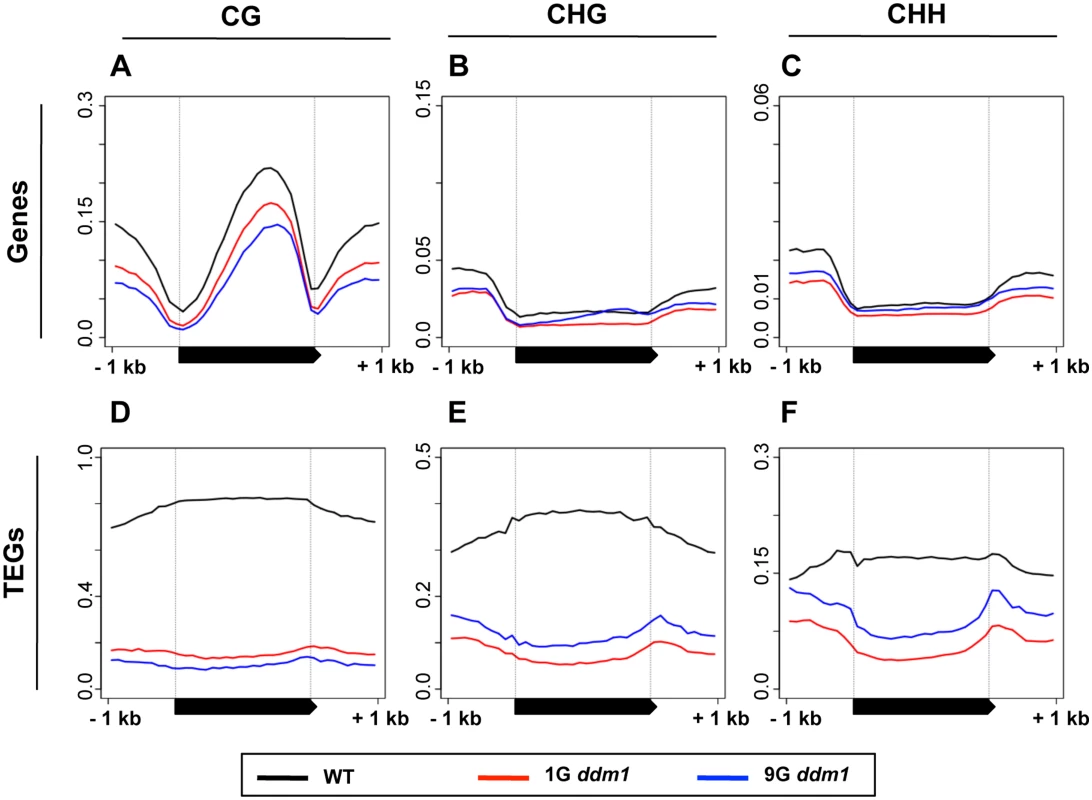
Progressive reduction of CG methylation in the self-pollinated ddm1 lines
Although the ddm1 mutation immediately induces a drastic loss of DNA methylation in repeats, further reduction of methylation in later generations has been reported for a few CG sites [30]. Our genome-wide analysis revealed that many loci behave in a similar manner (Fig 2A). The progressive reduction of DNA methylation can have significant phenotypic effects; for example, the promoter of the imprinted gene FWA remains methylated in the 1G ddm1 but the methylation is lost stochastically in 9G ddm1 (Fig 2B), generating heritable epialleles that cause late-flowering phenotype [31,36,38]. The progressive reduction is seen genome-wide for both genes and TEs (Fig 1A and 1D).
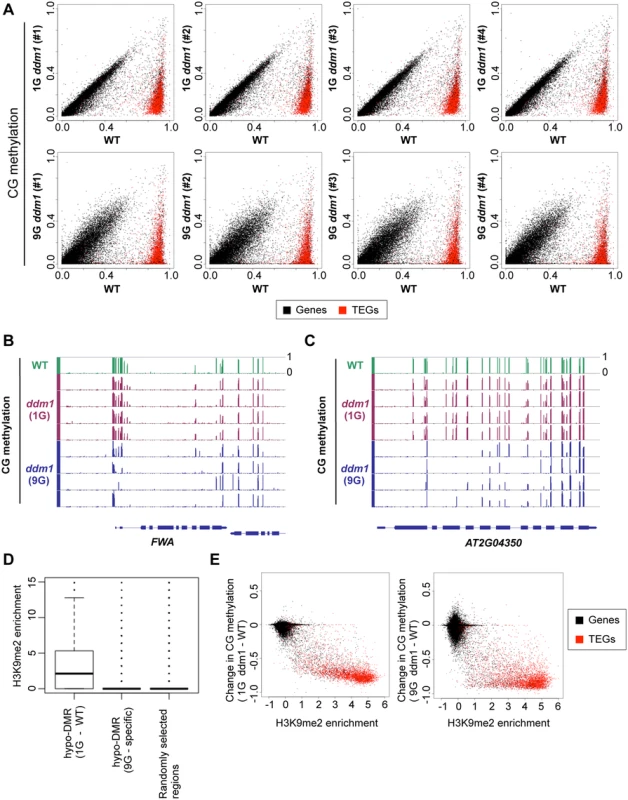
To compare the features of the regions hypomethylated immediately or gradually, we defined differentially methylated regions (DMRs; details in Materials and Methods). The regions ddm1 affects immediately (1G-WT DMRs) were enriched in dimethylation of histone H3 lysine 9 (H3K9me2) (Fig 2D left and 2E). H3K9me2 is a mark of silent heterochromatin, and these results are consistent with previous reports [10,26]. In marked contrast, however, regions affected slowly (9G-specific DMRs) have much lower level of H3K9me2 in wild type (Fig 2D middle). DDM1 gene function is necessary for CG methylation in heterochromatin, but in the long-term DDM1 also has significant effects on CG methylation in less heterochromatic regions including gene bodies (Fig 2C).
Accumulation of non-CG methylation in ddm1 lines after propagation by self-pollination
More counter-intuitively, our genome-wide analysis revealed a large number of genes and TEs ectopically hypermethylated at non-CG sites in the self-pollinated ddm1 lines (Figs 3A, 3B, 4A and 5A–5E). The regions CHG hypermethylated also showed hypermethylation at CHH sites (Figs 3D, 5A–5D, and S6A Fig). In addition, although genic CG methylation tends to decrease progressively from 1G to 9G on average (Figs 1 and 2), non-CG hypermethylated regions show an increase in CG methylation (Fig 3D). The CG and non-CG hypermethylation was found reproducibly at specific loci (S8 Fig). The affected loci include BONSAI and other sequences we have reported previously [37,39], but the majority of the affected loci could only be detected by whole-genome bisulfite sequencing (WGBS), because that can detect increased non-CG methylation with high sensitivity even at loci already CG methylated. In addition to genes, a large number of TEs showed increase in non-CG methylation (Figs 3A,3B, 4E, and S9–S11 Figs).
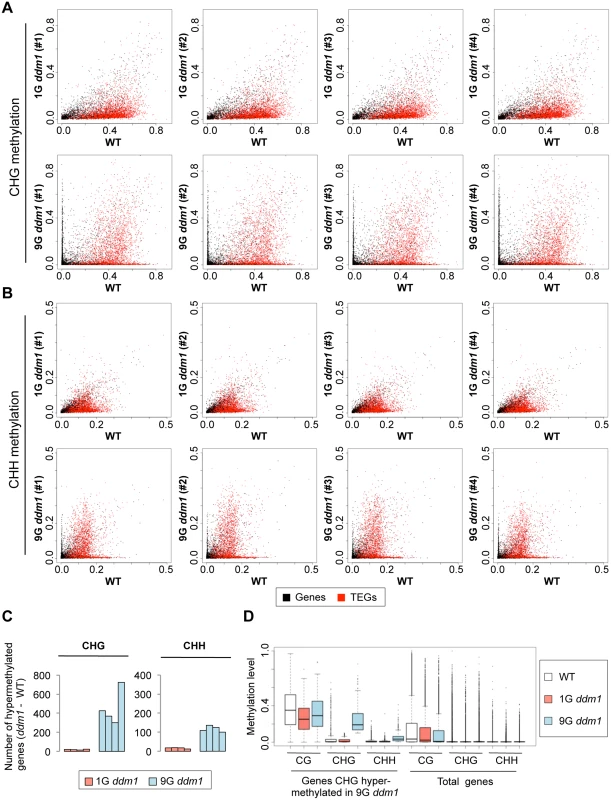
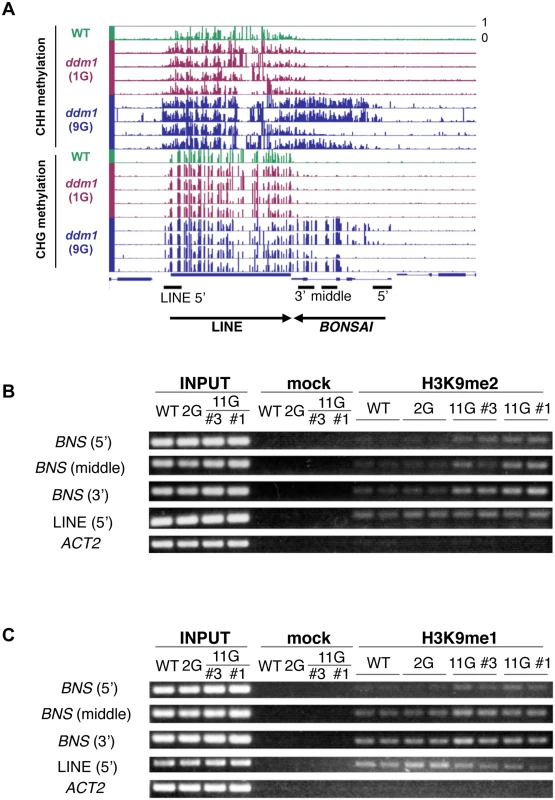
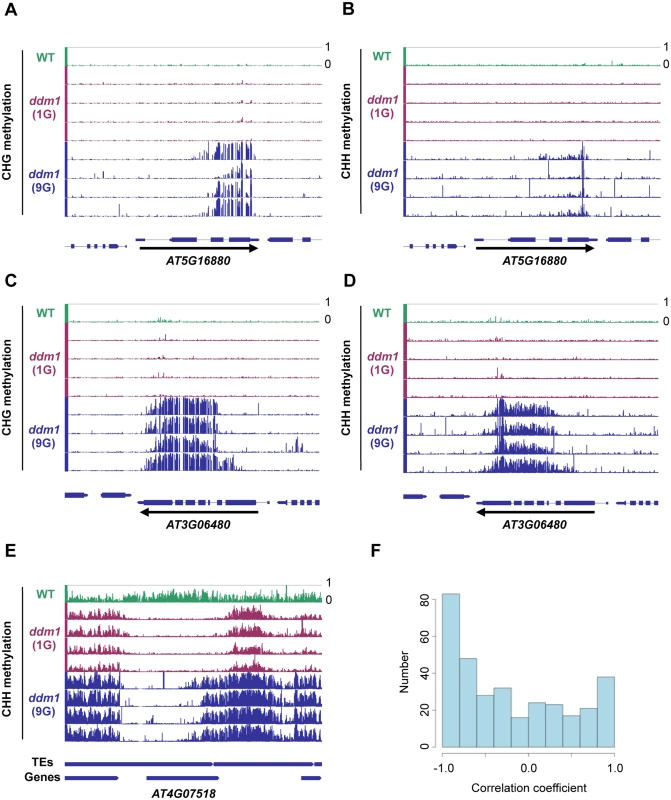
A very unexpected feature revealed by WGBS is that non-CG hypermethylation of genes is almost undetectable in the first generation of ddm1 but is specifically and reproducibly seen in the repeatedly self-pollinated ddm1 lines. In Fig 3A and 3B, many black dots can be seen along the vertical axis in the panels for 9G but not for 1G. The non-CG hypermethylation of genes is not a simple extension of the effect seen in the first generation. This feature can only be detected in later generations (Fig 3C). In order to further understand the transgenerational dynamics, we examined four independently self-pollinated 2G ddm1 plants. If the hypermethylation proceeds equally at each self-pollination, the increase from 1G to 2G would be 1/8 or more of the increase from 1G to 9G, provided that the methylation level should saturate at specific level (the methylation level can not exceed 100%). Interestingly, although hypermethylation proceeded in 2G, the difference between 1G and 2G was much less than 1/8 of that between 1G and 9G, suggesting that the increase is slow initially but accelerated in later generations (S12 and S13 Figs).
Spread of H3K9me and non-CG methylation in ddm1 mutants
How is this non-CG hypermethylation induced? Our genome-wide bisulfite analyses revealed that the genes non-CG hypermethylated in the self-pollinated ddm1 tend to have low levels of non-CG methylation already in wild type plants (Fig 3D), suggesting that preexisting small heterochromatin domains may function as seed for further heterochromatin formation. Interestingly, distribution of H3K9me2 around the DMR is asymmetric; it is enriched in the 3’ of the DMRs (S14 Fig). We have previously shown that the BONSAI gene is flanked by insertion of a heterochromatic LINE in the 3’ region [37] (Fig 4A and S13A Fig). The BONSAI hypermethylation in ddm1 is induced in a strain with the LINE insertion but not found in a strain without the LINE insertion [37]. The DNA methylation spreads from the 3’ LINE to the BONSAI region during repeated self-pollination of ddm1 mutants [37]. Spread of non-CG methylation from 3’ to 5’ regions was also noted at other loci (Fig 5A–5D). When the methylation level differs among the four 9G ddm1 plants, plants with stronger signals tended to show relative centroid positions more upstream than plants with weaker signals, suggesting that the signal spreads from 3’ to 5’ (Fig 5F). These observations suggest that common mechanisms may operate in BONSAI and many, even if not all, affected loci.
We have previously shown that the de novo non-CG methylation in the self-pollinated ddm1 does not require components of the RdDM machinery, such as RDR2, DCL3, and DRM2 [39]. On the other hand, the non-CG methylase CMT3 and H3K9 methylase KYP are necessary for the de novo methylation, suggesting that the ectopic methylation occurs by mechanisms mediated by the heterochromatin marks H3K9me and non-CG methylation [39]. Indeed, the non-CG hypermethylation at the BONSAI locus is associated with ectopic H3K9me (Fig 4B).
The self-reinforcing loop of non-CG methylase and H3K9 methylase activities could be the basis for the acceleration of hypermethylation as the generation proceeds (S13B Fig). As the two processes enhance each other, the positive feedback would accelerate the spread of the heterochromatin in later generations [12, 13].
Properties of loci hypermethylated in the self-pollinated ddm1
Increased non-CG methylation has been reported in mutants of the CG methyltransferase gene MET1 [40–42], which results at least in part from a reduction of full-length IBM1 transcript [43]. The IBM1 gene encodes a demethylase for histone H3K9; and mutation in this gene induces accumulation of H3K9me2 and non-CG methylation in gene bodies. Interestingly, developmental phenotypes of the ibm1 mutation also become progressively stronger during self-pollinations [15]. We compared the regions of non-CG hypermethylation in the ibm1 and self-pollinated ddm1. Although an overlap can be detected, the majority of the DMRs in ddm1 mutants before and after the self-pollinations were distinct from the DMRs of ibm1 mutants (Fig 6B and S16 Fig). Just as progressive loss of CG methylation in the ddm1 mutant, ibm1 mutant shows progressive accumulation of non-CG methylation in later generations (Fig 6A, S15 and S16 Figs). This is consistent with a recent report [44] and likely accounts for the progressive developmental defects in the ibm1 mutant.
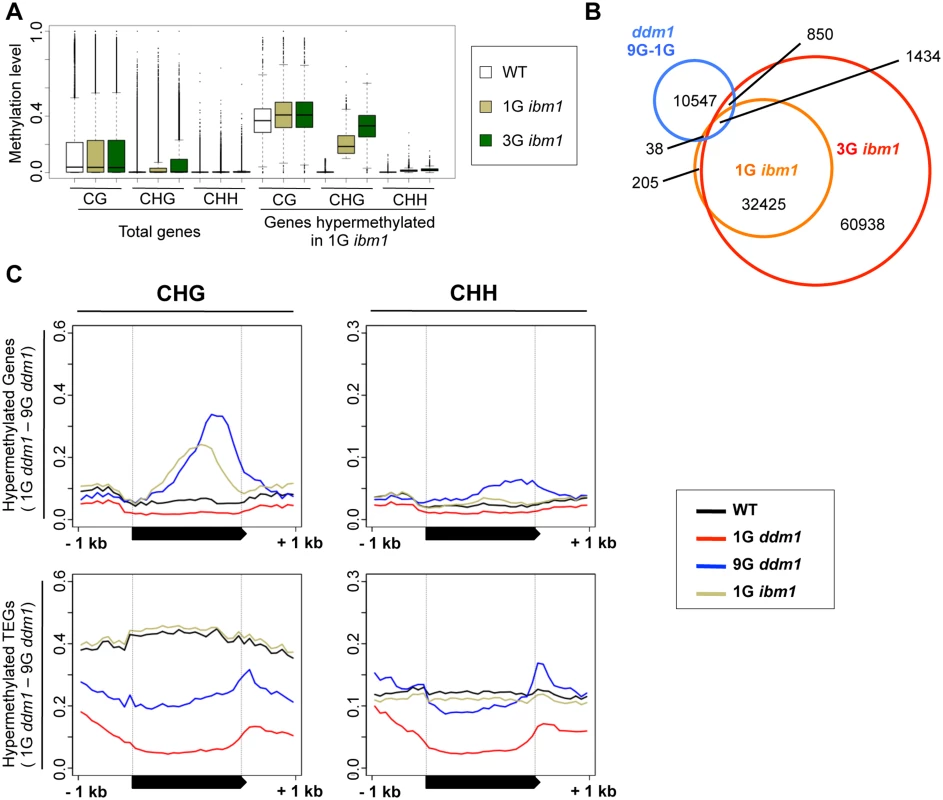
We examined DNA methylation patterns of the genes and TEs hypermethylated in the self-pollinated ddm1 lines (Fig 6C). Compared to the ibm1 mutant, the peak in the ddm1 was shifted toward 3’ end. Interestingly, the shift of the peak in the hypermethylation was also found for CG methylation (S5D Fig). Although CG methylation of gene body in wild type peaks around the center (S5C Fig), increase of genic CG methylation in 9G ddm1 was not proportional to the methylation of wild type; instead, the increase of CG methylation was shifted toward 3’ regions (S5D Fig). Together with the observation that CHG-hypermethylated genes tend to show CG-hypermethylation (Fig 3D), these results suggest a link between the ectopic CG methylation and non-CG methylation, as we discussed previously [39].
The bias of the hypermethylation signal toward the 3’ region in 9G ddm1 is especially evident in the hypermethylated TEs; the peak was often located outside of the transcription unit for both CHG and CHH methylations (Fig 6C, bottom half). When different families of TEs are compared, the peak in the downstream region was especially evident in the GYPSY-like LTR retrotransposons (S10 Fig). Generally, these TEs lost DNA methylation in 1G ddm1, but regained methylation during the self-pollinations (S5A and S9–S11 Figs).
The hypomethylated chromosomes from a ddm1 mutant could induce hypermethylation in trans even in a DDM1 wild type background
The ddm1 mutation can induce increased DNA methylation at hundreds of genes and TEs. The hypermethylation can be a direct consequence of impaired DDM1 function, or alternatively, an indirect effect of disruption of heterochromatin in the mutants. To test these possibilities, we examined the effect of chromosomes introduced from ddm1 into wild type DDM1 background. Chromosomes losing DNA methylation in the ddm1 mutants remain unmethylated even after introduction into wild type DDM1 background [25,45]. We examined DNA methylation data of epigenetic recombinant inbred lines (epiRILs) [46]. In the epiRILs, a ddm1 mutant plant was crossed to wild type plant twice to segregate DDM1/DDM1 lines with around one quarter of chromosome segments derived from ddm1. Although remethylation can be induced in regions associated with small RNA, hundreds of DMRs remain unmethylated in the wild type DDM1 background [46,47]. Each of these segregating lines have been self-pollinated seven times, which makes most of the genomic regions fixed in ddm1-derived haplotype or wild-type derived haplotype [46].
We examined if the loci exhibiting hypermethylation in the self-pollinated ddm1 lines also showed hypermethylation in some of the epiRILs. We utilized DNA methylation data for the 123 epiRILs, which are based on immunoprecipitation (IP) of genomic DNA by anti-methylcytosine antibody. As the context of methylation cannot be distinguished, we examined seven loci that show increased methylation in 9G ddm1 but a relatively low level of methylation at CG sites in wild-type. In six out of the seven loci examined, we could detect hypermethylation in multiple epiRILs, suggesting that the hypermethylation can be induced or maintained in the DDM1 background (Figs 7A, 7C, 7E and S17 Fig). In all of them, the hypermethylation showed a strong positive correlation with the amount of disrupted heterochromatin in each of these lines (Fig 7, S17 Fig and S1 Table), suggesting that the hypermethylation was induced or maintained in the background of disrupted heterochromatin in other genomic regions.
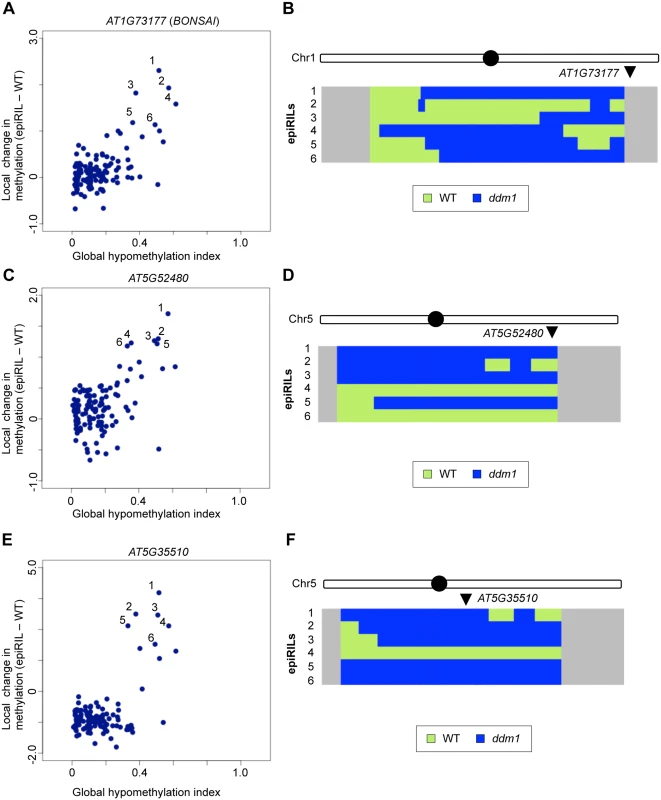
The hypermethylation could be induced de novo or alternatively maintained from the parental ddm1. The parental ddm1 plant originally used for making epiRILs was already self-pollinated three times (4G) and that plant also show low level of ectopic methylation at some loci (S17 Fig), which may have the potential to be maintained in DDM1 background [37]. Very importantly, however, the hypermethylation was found even in chromosome segments originated from wild type DDM1 (Figs 7B, 7D, 7F and S18–S23 Figs), demonstrating that the hypermethylation could be induced de novo after the initial crosses and subsequent repeated self-pollinations in the background of functional DDM1.
In order to confirm and extend this observation, we used WGBS for an epiRIL with genome-wide reduction of heterochromatic DNA methylation. The epiRIL98, which contains large amount of chromosomes with reduced DNA methylation, showed CHG hypermethylation in many genes (Fig 8A), which include BONSAI gene (S24A Fig) and genes with body methylation (S24B–S24C Fig). In the CHG hypermethylated genes, the CHG methylation level was generally much higher than that of the parental 4G ddm1 plant (Fig 8B), suggesting that the hypermethylation was amplified or induced de novo in the background of functional DDM1. A large number of CHG hypermethylated genes were found in chromosome regions of wild type haplotype (Fig 8C and S25 Fig), again suggesting that they can be induced de novo. In control epiRILs with much lower levels of disrupted chromatin, the hypermethylation was undetectable, confirming that the disrupted heterochromatin was responsible (Fig 8A). Taken together, these results indicate that the hypermethylation can be induced de novo by trans-acting effects of disrupted heterochromatin.
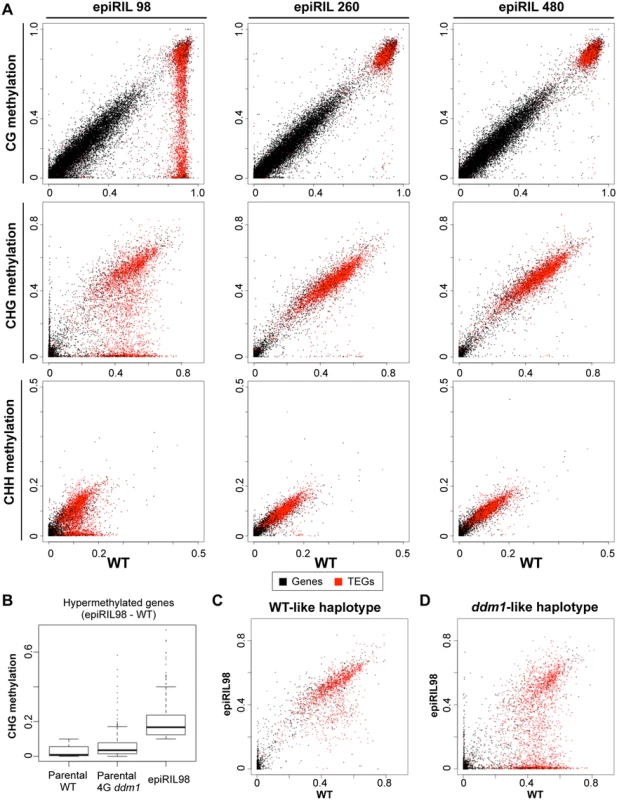
Discussion
Local spread of heterochromatin by positive feedback loop
Here we report short- and long-term effects of the ddm1 mutation. The mutation immediately induces a drastic loss of DNA methylation in heterochromatic regions in the first generation when it becomes homozygous. In later generations, the ddm1 mutation reproducibly induces ectopic accumulation of DNA methylation in hundreds of genes and TEs. This work and previous work [39] suggest that the ectopic methylation occurs by spread of heterochromatin marks mediated by the non-CG methylase CMT3 and H3K9 methylase KYP. Interestingly, this effect was slow in the initial generations but accelerated in later generations, suggesting strong positive cooperativity for the heterochromatin accumulation. That could be explained by the self-reinforcing positive feedback of H3K9me and non-CG methylation [12, 13].
Global negative feedback for heterochromatin redistribution
In addition to the local positive feedback, global negative feedback seems important for the DNA methylation dynamics. The ectopic DNA methylation seems to reflect negative feedback of disrupted heterochromatin in other genomic regions, because the ectopic methylation could also be induced in DDM1 wild type background when the genome contains large amount of chromosomal segments with disrupted heterochromatin (Figs 7 and 8). How does the negative feedback work? One possible explanation is that disruption of heterochromatin in the ddm1 mutant results in release of heterochromatin-forming factors such as CMTs and H3K9 methylases, which then become available in other regions. As these factors are normally recruited to heterochromatin, disruption of a large proportion of heterochromatin in the genome would result in increased level of these factors in released conditions, which would induce spread of heterochromatin into normally euchromatic regions and its amplification by the self-reinforcing loop of H3K9me and non-CG methylation (Fig 9).
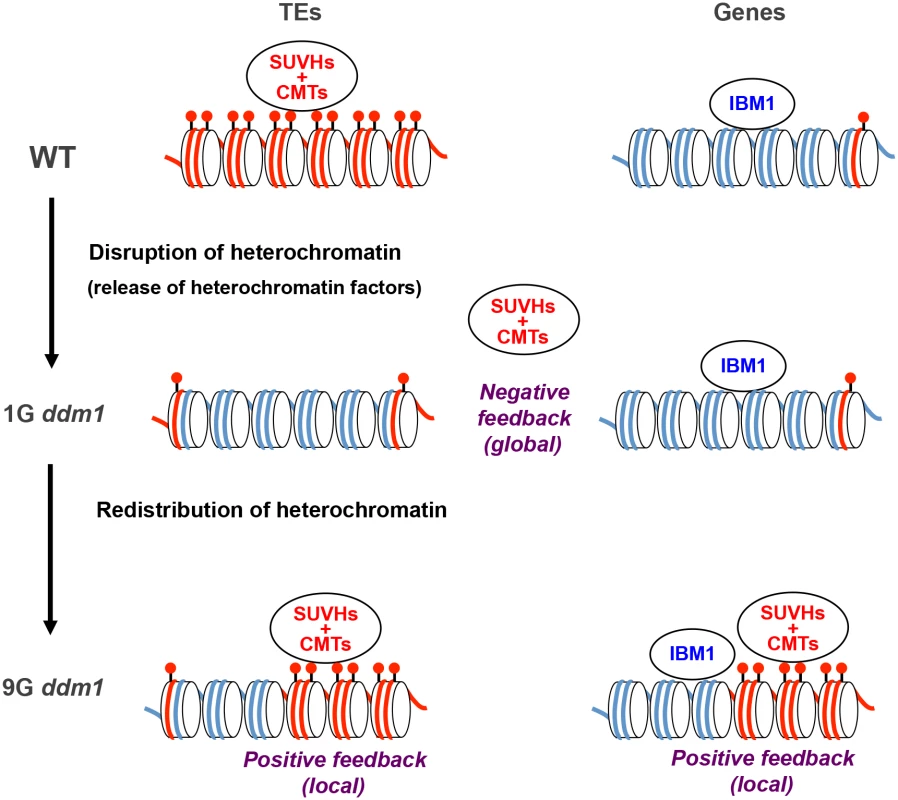
In the model we proposed, global reduction of heterochromatin induces ectopic non-CG methylation (Fig 9). That would account for the correlation between the global reduction of methylation and ectopic methylation in epiRILs (Fig 7A, 7C, 7E and S17 Fig). An alternative mechanism would be that ddm1 induces change in a specific locus, such as transcriptional de-repression or repression of a specific gene, and the change is inherited in the DDM1 wild type background and induces the ectopic methylation. For example, ROS1 gene expression is reduced in mutants with reduced DNA methylaiton [48], which would lead to hypermethylation at specific loci. However, although ROS1 gene expression is reduced in ddm1, it is expressed almost normally in epiRIL98, which show strong non-CG hypermethylation (S26A Fig). In addition, DMRs hypermethylated in 9G ddm1 and ros1-dml2-dml3 triple mutant do not overlap much, further suggesting that the hypermethylation in 9G ddm1 is not due to reduced ROS1 expression (S26B Fig). More generally, we could not find a locus consistently derived from ddm1 parent in all of the plants showing the high level of ectopic hypermethylation in the six loci (S18–S23 Figs). Although we cannot exclude the possibility that two or more specific loci redundantly mediate the ectopic methylation, a more parsimonious explanation derived from available data would be that the trans-interaction is mediated by global homeostasis.
The de novo methylation in the epiRILs might also be related to mechanisms such as paramutation [49,50], or transchromosomal methylation (TCM) [51]. In these phenomena, methylated sequences induce methylation in related sequences. However, the ectopic hypermethylation in the epiRILs is generally much higher than that of the parental ddm1 (Fig 8B), suggesting that even if paramutation-like or TCM-like mechanisms are involved, the effect should be much amplified during self-pollinations of epiRILs; and the degree of the amplification correlates with global disruption of heterochromatin (Fig 7 and S17 Fig), which is due to the ddm1-derived chromosomes.
This trans-acting negative feedback could also be understood as a hypersensitive reaction to the challenge by active and proliferating TEs. Our genome-wide analyses revealed that many of the TEs can be targets of the negative feedback (Fig 3A and 3B and S9–S11 Figs). Active TEs often keep parts of heterochromatin, which can function as seeds of the self-reinforcing heterochromatin formation.
An increase in non-CG methylation is also seen in mutants of the histone demethylase gene IBM1. However, targets of IBM1 are generally euchromatic and they do not overlap much with regions hypermethylated in the self-pollinated ddm1 lines (Fig 6B and S16 Fig). An increase in non-CG methylation is also found in the maintenance CG methylase gene MET1 [40–42]. As a mechanism for the met1-induced increase in non-CG methylation, loss of IBM1 function is suggested, as IBM1 transcripts become truncated in the met1 mutant [43]. On the other hand, it has been reported that the main targets of the met1-induced accumulation of H3K9me2 are genes with H3K27me3, another modification for silent chromatin [52]. The negative feedback of heterochromatin marks comparable to that seen in the self-pollinated ddm1 lines may also operate in met1 mutants. In our analyses, although regions affected by met1, ibm1, and self-pollinated ddm1 all differ, significant overlaps are noted (S27 Fig). For these mutants, the local triggers for heterochromatin accumulation appear to be distinct, despite the possible overlap in the downstream mechanisms, including the self-reinforcing loop of non-CG methylation and H3K9me.
Perspective
Heterochromatin homeostasis mechanisms analogous to those we have uncovered in Arabidopsis may also be operating in other eukaryotes. Mice with a disruption of its DDM1 homolog Lsh show global reduction of genomic DNA methylation, but interestingly it is also associated with increased DNA methylation at specific regions [29]. In human cancer, hypomethylation of repeats and TEs is often associated with local hypermethylation of genes, such as tumor suppressor genes [53,54]. In Drosophila, an increase in the amount of heterochromatic Y chromosome can results in a release of silencing at multiple loci in trans [55], suggesting a negative feedback similar to that discussed here. Furthermore, Drosophila modifiers of position effect variegation often function in dosage-dependent manners [56,57], consistent with the pathway proposed in Fig 9. Positive feedback loops would stabilize and enhance silent and active states [12,13,21,58], but they carry the risk of going out of control to excess. A global negative feedback mechanism, together with the local positive feedback, would ensure a robust and balanced chromatin differentiation within the genome, as has been discussed for pattern formation during development [59,60].
In the context of evolution in plants, a large variation in the amount of repetitive sequences is often noted between related species or even within a species [61–63]. On such occasions, fine-tuning of the amount of trans-acting heterochromatin factors would be especially important, as an imbalance would not only immediately affect gene expression level but also influence the epigenotype in a transgenerational manner.
Materials and Methods
Plant materials and annotations
Isolation of the ddm1-1 and ibm1-4 mutants has been described previously [15,25]. Self-pollination of ddm1 lines was described previously [30]. In order to remove heritable effects of the ddm1 mutation, the original ddm1 mutant was backcrossed six times in the heterozygous state. The heterozygous plants were propagated by self-pollination. 1G ddm1 mutant plants were selected from self-pollinated progeny of the heterozygote. 9G ddm1 plants were generated by independently self-pollinating different ddm1 segregants eight times (S1 Fig). Generation of epiRILs has been described previously [64].
The annotations of genes and TEs are based on The Arabidopsis Information Resource (http://www.arabidopsis.org/). TAIR8 was used for analyzing ChIP chip data (Fig 2E), TEG (TE gene) data, and epiRILs data. TAIR10 was used for other analyses. The details of the annotation of TEGs were described in a document in TAIR web (ftp://ftp.arabidopsis.org/home/tair/Genes/TAIR8_genome_release/Readme-transposons).
DNA methylation analyses
For the 1G and 9G ddm1 plants and their controls, genomic DNA was isolated from rosette leaves using the Illustra Nucleon Phytopure genomic DNA extraction kit, and genome-wide bisulfite sequencing was performed as described previously [65]. Raw sequence data were deposited in the DDBJ (DNA Data Bank of Japan) Sequence Read Archive (DRA; accession nos. DRA002545, DRA002546, DRA002548, DRA002549, DRA002551, DRA002554, DRA002555, DRA003018, DRA003019 and DRA003020). The adaptor sequences were clipped out using the FASTX-toolkit (http://hannonlab.cshl.edu/fastx_toolkit/). Reads were trimmed to 90 nucleotide length (45 nucleotide for the data obtained from GEO—GSE39901) and mapped to reference genomes (Release 10 of the Arabidopsis Information Resources) using the Bowtie alignment algorithm [66] with the following parameters, "-X 500-e 90-l 20-n 1". Only uniquely mapped reads were used. Clonal reads were removed except one with the best quality. Any read with three consecutive methylated CHH sites were eliminated. The level of methylation of cytosine in a genomic region was calculated using the ratio of the number of methylated cytosine to that of total cytosine. For the three epiRILs and two parental lines, whole-genome bisulfite sequencing was described previously [46] and the data are in GEO (GSE62206).
DMRs (differentially methylated regions) were defined by comparing the methylation level of 100-bp windows throughout the genome between two genotypes. The windows with at least 20 sequenced cytosines were used for the comparison. The level of methylation was calculated using the weighed methylation level of each genotype [67]. The windows were selected as DMRs when difference of methylation level was 0.5 or more at CG site or 0.3 or more at CHG sites. For defining contiguous DMR (conDMR), multiple DMRs were merged if they were adjacent to each other or there was only one gap of the 100-bp window. The centroid of cytosine methylation in conDMR was calculated using the relative position within that region weighed by methylation level of each cytosine. In Fig 5F, we used conDMR of 500 bp or longer and overlapping with genes. Each contiguous DMR was aligned according to the orientation of the corresponding gene. The correlation coefficient between the level and the relative centroid position of DNA methylation was calculated among the four 9G ddm1 plants in each conDMR. To plot DNA methylation patterns over genes or TEGs in ddm1 mutants, #1 samples of each genotype (Figs 2A, 3A and 3B) in 1G ddm1 and 9G ddm1 were used. To draw the heatmap of methylation of cytosine, cluster 3.0 [68] and Java Treeview [69] were used.
Chromatin IP analysis
15-day-old seedlings were fixed with formaldehyde and ChIP was performed as described previously [70], using antibody against H3K9me1 (CMA316) and H3K9me2 (CMA307) [71]. To assure the equal amount of chromatin in each line, input DNA were quantified by quantitative PCR using TaKaRa Dice_Real Time System TP800 and ACT7 primers. Then, input DNA and each sample were diluted according to the estimated input DNA concentrations. Input DNA, mock (without antibody), and ChIP samples were analyzed by PCR. The PCR conditions were as follows: pre-incubation for 2 min at 94°C, 27 cycles at 94°C for 30 sec, 58°C for 20 sec, 72°C for 45 sec and a final extension at 72°C for 4 min. Primers used for the ChIP are listed in S2 Table. In addition to the BONSAI locus, we examined six loci with CHG methylation increased more than 0.3 from 1G ddm1 to 9G ddm1. Three of them were selected for relatively high level of ectopic CHH methylation (H1, H2, H3) and three with relatively low CHH methylation (L1, L2, L3). The increase of CHH methylation from 1G ddm1 to 9G ddm1 is more than 0.2 for the three H loci, and it is less than 0.02 for the three L loci. The lengths of amplicons for the six loci are between 250 bp and 300 bp.
Processing ChIP-seq data
ChIP-seq data of various histone modifications [72] in GEO (GSE28398) were used for our analysis. The coordinates were remapped onto TAIR10 annotation using a script in TAIR [73]. Enrichment of histone modification in a DMR was calculated by the density of ChIP-seq reads, and normalized by the mean and the standard deviation of the density of reads in 100,000 windows randomly chosen across the genome.
Processing MeDIP-chip data of epiRILs
The MeDIP-chip data of 123 epigenetic recombinant inbred lines (epiRILs), ddm1 and WT are in GEO (GSE37284). The regions that were methylated (M) in WT and unmethylated (U) in ddm1 were selected as targets of ddm1 mutation using the values for HMM (hidden Markov model) status (M (methylated) or I (Intermediate) or U (Unmethylated)) [46]. Global hypo-methylation index of an epiRIL was calculated as the genome-wide average of the values for HMM status of probes on the chip (M = 0, I = 0.5, U = 1) in the target regions of ddm1 mutation. The data of inference of inherited haplotypes were shown in the previous study [46]. Following are names of lines numbered 1–6 in Fig 7 and S18–S23 Figs. (Fig 7A and 7B and S18 Fig) epiRIL208 epiRIL122 epiRIL98 epiRIL232 epiRIL70 epiRIL114; (Fig 7C and 7D and S19 Fig) epiRIL122 epiRIL208 epiRIL114 epiRIL258 epiRIL438 epiRIL508; (Fig 7E and 7F and S20 Fig) epiRIL208 epiRIL98 epiRIL438 epiRIL508 epiRIL122 epiRIL114; (S21 Fig) epiRIL208 epiRIL73 epiRIL71 epiRIL394 epiRIL98 epiRIL438; (S22 Fig) epiRIL508 epiRIL114 epiRIL122 epiRIL438 epiRIL208 epiRIL93; (S23 Fig) epiRIL208 epiRIL114 epiRIL556 epiRIL71 epiRIL244 epiRIL98.
Supporting Information
Zdroje
1. Kelly WG (2014) Transgenerational epigenetics in the germline cycle of Caenorhabditis elegans. Epigenetics Chromatin 7: 6. doi: 10.1186/1756-8935-7-6 24678826
2. Heard E, Martienssen RA (2014) Transgenerational epigenetic inheritance: myths and mechanisms. Cell 157: 95–109. doi: 10.1016/j.cell.2014.02.045 24679529
3. Kakutani T (2002) Epi-alleles in plants: inheritance of epigenetic information over generations. Plant Cell Physiol 43: 1106–1111. 12407189
4. Richards EJ (2011) Natural epigenetic variation in plant species: a view from the field. Curr Opin Plant Biol 14: 204–209. doi: 10.1016/j.pbi.2011.03.009 21478048
5. Weigel D, Colot V (2012) Epialleles in plant evolution. Genome Biol 13: 249. doi: 10.1186/gb-2012-13-10-249 23058244
6. Schmitz RJ, Schultz MD, Lewsey MG, O'Malley RC, Urich MA, Libiger O, et al. (2011) Transgenerational epigenetic instability is a source of novel methylation variants. Science 334: 369–373. doi: 10.1126/science.1212959 21921155
7. Becker C, Hagmann J, Müller J, Koenig D, Stegle O, Borgwardt K, et al. (2011) Spontaneous epigenetic variation in the Arabidopsis thaliana methylome. Nature 480: 245–249. doi: 10.1038/nature10555 22057020
8. Finnegan EJ, Peacock WJ, Dennis ES (1996) Reduced DNA methylation in Arabidopsis thaliana results in abnormal plant development. Proc Natl Acad Sci U S A 93: 8449–8454. 8710891
9. Kankel MW, Ramsey DE, Stokes TL, Flowers SK, Haag JR, Jeddeloh JA, et al. (2003) Arabidopsis MET1 cytosine methyltransferase mutants. Genetics. 163: 1109–1122. 12663548
10. Zemach A, Kim MY, Hsieh PH, Coleman-Derr D, Eshed-Williams L, Thao K, et al. (2013) The Arabidopsis nucleosome remodeler DDM1 allows DNA methyltransferases to access H1-containing heterochromatin. Cell 153: 193–205. doi: 10.1016/j.cell.2013.02.033 23540698
11. Stroud H, Do T, Du J, Zhong X, Feng S, Johnson L, et al. (2014) Non-CG methylation patterns shape the epigenetic landscape in Arabidopsis. Nat Struct Mol Biol 21: 64–72. doi: 10.1038/nsmb.2735 24336224
12. Johnson LM, Bostick M, Zhang X, Kraft E, Henderson I, Callis J, et al. (2007) The SRA methyl-cytosine-binding domain links DNA and histone methylation. Curr Biol 17: 379–384. 17239600
13. Inagaki S, Miura-Kamio A, Nakamura Y, Lu F, Cui X, Cao X, et al. (2010) Autocatalytic differentiation of epigenetic modifications within the Arabidopsis genome. EMBO J 29: 3496–3506. doi: 10.1038/emboj.2010.227 20834229
14. Du J, Zhong X, Bernatavichute YV, Stroud H, Feng S, Caro E, et al. (2012) Dual binding of chromomethylase domains to H3K9me2-containing nucleosomes directs DNA methylation in plants. Cell 151:167–180. doi: 10.1016/j.cell.2012.07.034 23021223
15. Saze H, Shiraishi A, Miura A, Kakutani T (2008) Control of genic DNA methylation by a jmjC domain-containing protein in Arabidopsis thaliana. Science 319: 462–465. doi: 10.1126/science.1150987 18218897
16. Mette MF, Aufsatz W, van der Winden J, Matzke MA, Matzke AJ. (2000) Transcriptional silencing and promoter methylation triggered by double-stranded RNA. EMBO J 19: 5194–5201. 11013221
17. Cao X, Aufsatz W, Zilberman D, Mette MF, Huang MS, Matzke M, et al. (2003) Role of the DRM and CMT3 methyltransferases in RNA-directed DNA methylation. Curr Biol 13: 2212–2217. 14680640
18. Law JA, Jacobsen SE (2010) Establishing, maintaining and modifying DNA methylation patterns in plants and animals. Nat Rev Genet 11:204–220. doi: 10.1038/nrg2719 20142834
19. Furner IJ, Matzke M (2011) Methylation and demethylation of the Arabidopsis genome. Curr Opin Plant Biol 14: 137–141. doi: 10.1016/j.pbi.2010.11.004 21159546
20. Pikaard CS, Haag JR, Pontes OM, Blevins T, Cocklin R (2012) A transcription fork model for Pol IV and Pol V-dependent RNA-directed DNA methylation. Cold Spring Harb Symp Quant Biol 77:205–212. doi: 10.1101/sqb.2013.77.014803 23567894
21. Zilberman D, Cao X, Johansen LK, Xie Z, Carrington JC, Jacobsen SE (2004) Role of Arabidopsis ARGONAUTE4 in RNA-directed DNA methylation triggered by inverted repeats. Curr Biol 14: 1214–1220. 15242620
22. Henderson IR, Deleris A, Wong W, Zhong X, Chin HG, Horwitz GA, et al. (2010) The de novo cytosine methyltransferase DRM2 requires intact UBA domains and a catalytically mutated paralog DRM3 during RNA-directed DNA methylation in Arabidopsis thaliana. PLoS Genet 6: e1001182. doi: 10.1371/journal.pgen.1001182 21060858
23. Zhang X, Yazaki J, Sundaresan A, Cokus S, Chan SW, Chen H, et al. (2006) Genome-wide high-resolution mapping and functional analysis of DNA methylation in arabidopsis. Cell 126: 1189–1201. 16949657
24. Stroud H, Greenberg MV, Feng S, Bernatavichute YV, Jacobsen SE (2013) Comprehensive analysis of silencing mutants reveals complex regulation of the Arabidopsis methylome. Cell 152: 352–364. doi: 10.1016/j.cell.2012.10.054 23313553
25. Vongs A, Kakutani T, Martienssen RA, Richards EJ (1993) Arabidopsis thaliana DNA methylation mutants. Science 260: 1926–1928. 8316832
26. Lippman Z, Gendrel AV, Black M, Vaughn MW, Dedhia N, McCombie WR, et al. (2004) Role of transposable elements in heterochromatin and epigenetic control. Nature 430: 471–476. 15269773
27. Jeddeloh JA, Stokes TL, Richards EJ (1999) Maintenance of genomic methylation requires a SWI2/SNF2-like protein. Nat Genet 22: 94–97. 10319870
28. Dennis K, Fan T, Geiman T, Yan Q, Muegge K (2001) Lsh, a member of the SNF2 family, is required for genome-wide methylation. Genes Dev 15: 2940–2944. 11711429
29. Tao Y, Xi S, Shan J, Maunakea A, Che A, Briones V, et al. (2011) Lsh, chromatin remodeling family member, modulates genome-wide cytosine methylation patterns at nonrepeat sequences. Proc Natl Acad Sci U S A 108: 5626–5631. doi: 10.1073/pnas.1017000108 21427231
30. Kakutani T, Jeddeloh JA, Flowers SK, Munakata K, Richards EJ (1996) Developmental abnormalities and epimutations associated with DNA hypomethylation mutations. Proc Natl Acad Sci U S A 22: 12406–12411. 8901594
31. Kakutani T (1997) Genetic characterization of late-flowering traits induced by DNA hypomethylation mutation in Arabidopsis thaliana. Plant J 12: 1447–1451. 9450349
32. Miura A, Yonebayashi S, Watanabe K, Toyama T, Shimada H, Kakutani T (2001) Mobilization of transposons by a mutation abolishing full DNA methylation in Arabidopsis. Nature 411: 212–214. 11346800
33. Singer T, Yordan C, Martienssen RA (2001) Robertson's Mutator transposons in A. thaliana are regulated by the chromatin-remodeling gene Decrease in DNA Methylation (DDM1). Genes Dev 15: 591–602. 11238379
34. Tsukahara S, Kobayashi A, Kawabe A, Mathieu O, Miura A, Kakutani T (2009) Bursts of retrotransposition reproduced in Arabidopsis. Nature 461: 423–426. doi: 10.1038/nature08351 19734880
35. Yi H, Richards EJ (2009) Gene duplication and hypermutation of the pathogen Resistance gene SNC1 in the Arabidopsis bal variant. Genetics 183: 1227–1234. doi: 10.1534/genetics.109.105569 19797048
36. Soppe WJ, Jacobsen SE, Alonso-Blanco C, Jackson JP, Kakutani T, Koornneef M, et al. (2000) The late flowering phenotype of fwa mutants is caused by gain-of-function epigenetic alleles of a homeodomain gene. Mol Cell 4: 791–802. 11090618
37. Saze H, Kakutani T (2007) Heritable epigenetic mutation of a transposon-flanked Arabidopsis gene due to lack of the chromatin-remodeling factor DDM1. EMBO J 26: 3641–3652. 17627280
38. Kinoshita Y, Saze H, Kinoshita T, Miura A, Soppe WJ, Koornneef M, et al. (2007) Control of FWA gene silencing in Arabidopsis thaliana by SINE-related direct repeats. Plant J 49:38–45. 17144899
39. Sasaki T, Kobayashi A, Saze H, Kakutani T (2012) RNAi-independent de novo DNA methylation revealed in Arabidopsis mutants of chromatin remodeling gene DDM1. Plant J 70: 750–758. doi: 10.1111/j.1365-313X.2012.04911.x 22269081
40. Jacobsen SE, Meyerowitz E (1997) Hypermethylated SUPERMAN Epigenetic Alleles in Arabidopsis. Science 277: 1100–1103. 9262479
41. Kishimoto N, Sakai H, Jackson J, Jacobsen SE, Meyerowitz EM, Dennis ES, et al. (2001) Site specificity of the Arabidopsis METI DNA methyltransferase demonstrated through hypermethylation of the superman locus. Plant Mol Biol 46: 171–183. 11442057
42. Mathieu O, Reinders J, Caikovski M, Smathajitt C, Paszkowski J (2007) Transgenerational stability of the Arabidopsis epigenome is coordinated by CG methylation. Cell 130: 851–862. 17803908
43. Rigal M, Kevei Z, Pélissier T, Mathieu O (2012) DNA methylation in an intron of the IBM1 histone demethylase gene stabilizes chromatin modification patterns. EMBO J 31: 2981–2993. doi: 10.1038/emboj.2012.141 22580822
44. Coleman-Derr D, Zilberman D (2012) Deposition of histone variant H2A.Z within gene bodies regulates responsive genes. PLoS Genet 8: e1002988. doi: 10.1371/journal.pgen.1002988 23071449
45. Kakutani T, Munakata K, Richards EJ, Hirochika H (1999) Meiotically and mitotically stable inheritance of DNA hypomethylation induced by ddm1 mutation of Arabidopsis thaliana. Genetics 151: 831–838. 9927473
46. Colomé-Tatché M, Cortijo S, Wardenaar R, Morgado L, Lahouze B, Sarazin A, et al. (2012) Features of the Arabidopsis recombination landscape resulting from the combined loss of sequence variation and DNA methylation. Proc Natl Acad Sci U S A 109:16240–16245. doi: 10.1073/pnas.1212955109 22988127
47. Teixeira FK, Heredia F, Sarazin A, Roudier F, Boccara M, Ciaudo C, et al. (2009) A role for RNAi in the selective correction of DNA methylation defects. Science 323: 1600–1604. doi: 10.1126/science.1165313 19179494
48. Huettel B, Kanno T, Daxinger L, Aufsatz W, Matzke AJ, Matzke M (2006) Endogenous targets of RNA-directed DNA methylation and Pol IV in Arabidopsis. EMBO J 25: 2828–2836. 16724114
49. Arteaga-Vazquez MA, Chandler VL. (2010) Paramutation in maize: RNA mediated trans-generational gene silencing. Curr Opin Genet Dev 20: 156–163. doi: 10.1016/j.gde.2010.01.008 20153628
50. Hollick JB. (2012) Paramutation: a trans-homolog interaction affecting heritable gene regulation. Curr Opin Plant Biol 15:536–543. doi: 10.1016/j.pbi.2012.09.003 23017240
51. Greaves IK, Groszmann M, Ying H, Taylor JM, Peacock WJ, Dennis ES (2012) Trans chromosomal methylation in Arabidopsis hybrids. Proc Natl Acad Sci U S A 109:3570–3575. doi: 10.1073/pnas.1201043109 22331882
52. Deleris A, Stroud H, Bernatavichute Y, Johnson E, Klein G, Schubert D, et al. (2012) Loss of the DNA methyltransferase MET1 Induces H3K9 hypermethylation at PcG target genes and redistribution of H3K27 trimethylation to transposons in Arabidopsis thaliana. PLoS Genet 8: e1003062. doi: 10.1371/journal.pgen.1003062 23209430
53. Ross JP, Rand KN, Molloy PL (2010) Hypomethylation of repeated DNA sequences in cancer. Epigenomics 2: 245–269. doi: 10.2217/epi.10.2 22121873
54. Ehrlich M (2009) DNA hypomethylation in cancer cells. Epigenomics 1: 239–259. doi: 10.2217/epi.09.33 20495664
55. Dimitri P, Pisano C (1989) Position effect variegation in Drosophila melanogaster: relationship between suppression effect and the amount of Y chromosome. Genetics 122: 793–800. 2503420
56. Locke J, Kotarski MA, Tartof KD (1988) Dosage-dependent modifiers of position effect variegation in Drosophila and a mass action model that explains their effect. Genetics 120: 181–198. 3146523
57. Henikoff S (1996) Dosage-dependent modification of position-effect variegation in Drosophila. Bioessays 18: 401–409. 8639163
58. Inagaki S, Kakutani T (2013) What triggers differential DNA methylation of genes and TEs: contribution of body methylation? Cold Spring Harb Symp Quant Biol 2012 77:155–160. doi: 10.1101/sqb.2013.77.016212 23302809
59. Turing AM (1953) The chemical basis of morphogenesis. Philos Trans R Soc Lond B Biol Sci 237: 37–72.
60. Meinhardt H, Gierer A (2000) Pattern formation by local self-activation and lateral inhibition. Bioessays 22: 753–760. 10918306
61. Hawkins JS, Kim H, Nason JD, Wing RA, Wendel JF (2006) Differential lineage-specific amplification of transposable elements is responsible for genome size variation in Gossypium. Genome Res 16: 1252–1261. 16954538
62. Cullis CA (2005) Mechanisms and control of rapid genomic changes in flax. Ann Bot 95: 201–206. 15596467
63. Woo HR, Richards EJ (2008) Natural variation in DNA methylation in ribosomal RNA genes of Arabidopsis thaliana. BMC Plant Biol 8: 92. doi: 10.1186/1471-2229-8-92 18783613
64. Johannes F, Porcher E, Teixeira FK, Saliba-Colombani V, Simon M, Agier N, et al. (2009) Assessing the impact of transgenerational epigenetic variation on complex traits. PLoS Genet. 5: e1000530. doi: 10.1371/journal.pgen.1000530 19557164
65. Fu Y, Kawabe A, Etcheverry M, Ito T, Toyoda A, Fujiyama A, et al. (2013) Mobilization of a plant transposon by expression of the transposon-encoded anti-silencing factor. EMBO J 32: 2407–2417. doi: 10.1038/emboj.2013.169 23900287
66. Langmead B, Trapnell C, Pop M, Salzberg SL (2009) Ultrafast and memory-efficient alignment of short DNA sequences to the human genome. Genome Biol 10: R25. doi: 10.1186/gb-2009-10-3-r25 19261174
67. Schultz MD, Schmitz RJ, Ecker JR (2012) 'Leveling' the playing field for analyses of single-base resolution DNA methylomes. Trends Genet 28: 583–585. doi: 10.1016/j.tig.2012.10.012 23131467
68. de Hoon MJ, Imoto S, Nolan J, Miyano S (2004) Open source clustering software. Bioinformatics 20:1453–1454. 14871861
69. Saldanha AJ (2004) Java Treeview—extensible visualization of microarray data. Bioinformatics 20: 3246–3248. 15180930
70. Gendrel AV, Lippman Z, Martienssen R, Colot V (2005) Profiling histone modification patterns in plants using genomic tiling microarrays. Nat Protocols 2: 213–218.
71. Hayashi-Takanaka Y, Yamagata K, Wakayama T, Stasevich TJ, Kainuma T, Tsurimoto T, et al. (2011) Tracking epigenetic histone modifications in single cells using Fab-based live endogenous modification labeling. Nucleic Acids Res. 39: 6475–88. doi: 10.1093/nar/gkr343 21576221
72. Luo C, Sidote DJ, Zhang Y, Kerstetter RA, Michael TP, Lam E (2013) Integrative analysis of chromatin states in Arabidopsis identified potential regulatory mechanisms for natural antisense transcript production. Plant J 73: 77–90.
73. Lamesch P, Berardini TZ, Li D, Swarbreck D, Wilks C, Sasidharan R, et al. (2012) The Arabidopsis Information Resource (TAIR): improved gene annotation and new tools. Nucleic Acids Res 40: D1202–1210. doi: 10.1093/nar/gkr1090 22140109
74. Nicol JW, Helt GA, Blanchard SG, Raja A, Loraine AE (2009) The Integrated Genome Browser: free software for distribution and exploration of genome-scale datasets. Bioinformatics 25: 2730–2731. doi: 10.1093/bioinformatics/btp472 19654113
75. Ebbs ML, Bender J (2006) Locus-specific control of DNA methylation by the Arabidopsis SUVH5 histone methyltransferase. Plant Cell 18:1166–1176. 16582009
76. Penterman J, Zilberman D, Huh JH, Ballinger T, Henikoff S, Fischer RL (2007) DNA demethylation in the Arabidopsis genome. Proc Natl Acad Sci U S A 104:6752–6757. 17409185
Štítky
Genetika Reprodukční medicínaČlánek vyšel v časopise
PLOS Genetics
2015 Číslo 4
- Mateřský haplotyp KIR ovlivňuje porodnost živých dětí po transferu dvou embryí v rámci fertilizace in vitro u pacientek s opakujícími se samovolnými potraty nebo poruchami implantace
- Intrauterinní inseminace a její úspěšnost
- Akutní intermitentní porfyrie
- Srdeční frekvence embrya může být faktorem užitečným v předpovídání výsledku IVF
- Šanci na úspěšný průběh těhotenství snižují nevhodné hladiny progesteronu vznikající při umělém oplodnění
Nejčtenější v tomto čísle
- Lack of GDAP1 Induces Neuronal Calcium and Mitochondrial Defects in a Knockout Mouse Model of Charcot-Marie-Tooth Neuropathy
- Proteolysis of Virulence Regulator ToxR Is Associated with Entry of into a Dormant State
- Frameshift Variant Associated with Novel Hoof Specific Phenotype in Connemara Ponies
- Ataxin-2 Regulates Translation in a New BAC-SCA2 Transgenic Mouse Model
